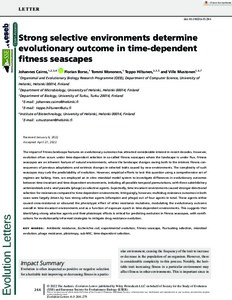Strong selective environments determine evolutionary outcome in time-dependent fitness seascapes
Cairns Johannes; Borse Florian; Mononen Tommi; Hiltunen Teppo; Mustonen Ville
Strong selective environments determine evolutionary outcome in time-dependent fitness seascapes
Cairns Johannes
Borse Florian
Mononen Tommi
Hiltunen Teppo
Mustonen Ville
JOHN WILEY & SONS LTD
Julkaisun pysyvä osoite on:
https://urn.fi/URN:NBN:fi-fe2022081155006
https://urn.fi/URN:NBN:fi-fe2022081155006
Tiivistelmä
The impact of fitness landscape features on evolutionary outcomes has attracted considerable interest in recent decades. However, evolution often occurs under time-dependent selection in so-called fitness seascapes where the landscape is under flux. Fitness seascapes are an inherent feature of natural environments, where the landscape changes owing both to the intrinsic fitness consequences of previous adaptations and extrinsic changes in selected traits caused by new environments. The complexity of such seascapes may curb the predictability of evolution. However, empirical efforts to test this question using a comprehensive set of regimes are lacking. Here, we employed an in vitro microbial model system to investigate differences in evolutionary outcomes between time-invariant and time-dependent environments, including all possible temporal permutations, with three subinhibitory antimicrobials and a viral parasite (phage) as selective agents. Expectedly, time-invariant environments caused stronger directional selection for resistances compared to time-dependent environments. Intriguingly, however, multidrug resistance outcomes in both cases were largely driven by two strong selective agents (rifampicin and phage) out of four agents in total. These agents either caused cross-resistance or obscured the phenotypic effect of other resistance mutations, modulating the evolutionary outcome overall in time-invariant environments and as a function of exposure epoch in time-dependent environments. This suggests that identifying strong selective agents and their pleiotropic effects is critical for predicting evolution in fitness seascapes, with ramifications for evolutionarily informed strategies to mitigate drug resistance evolution.
Kokoelmat
- Rinnakkaistallenteet [27094]
